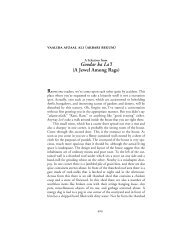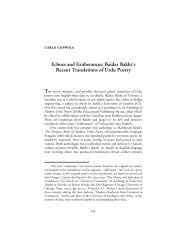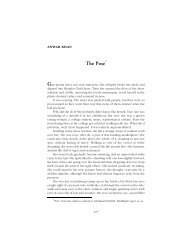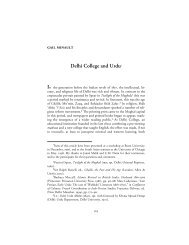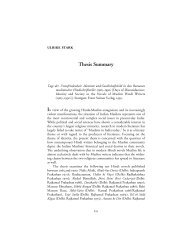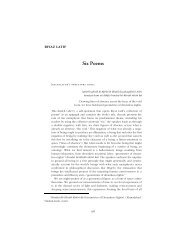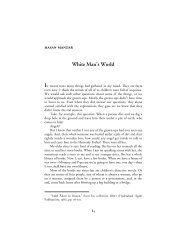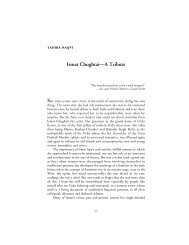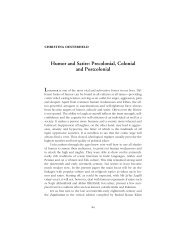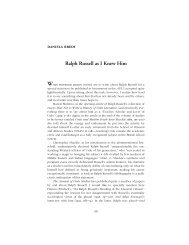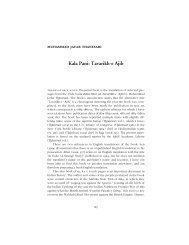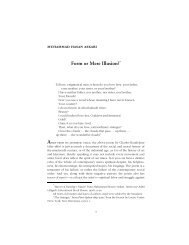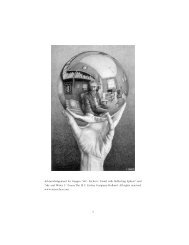Politics, Public Issues and the Promotion of Urdu Literature: Avadh ...
Politics, Public Issues and the Promotion of Urdu Literature: Avadh ...
Politics, Public Issues and the Promotion of Urdu Literature: Avadh ...
You also want an ePaper? Increase the reach of your titles
YUMPU automatically turns print PDFs into web optimized ePapers that Google loves.
ULRIKE STARK • 67forty years, during which it made a distinct impact on <strong>the</strong> emerging <strong>Urdu</strong>public sphere. Outlining <strong>the</strong> growth, contents <strong>and</strong> policy <strong>of</strong> AA, it willlook at both economic <strong>and</strong> human factors in <strong>the</strong> making <strong>of</strong> an outst<strong>and</strong>ingpopular success in nineteenth-century <strong>Urdu</strong> journalism. 2Munshi Naval Kishore (1836–95) is one <strong>of</strong> several eminent Hindupublicists who figure prominently in <strong>the</strong> history <strong>of</strong> nineteenth-century<strong>Urdu</strong> journalism. Following his higher education at Agra College, hewent to Lahore to receive his training as a printer <strong>and</strong> journalist at <strong>the</strong>famous Kåh-e N∑r Press (est. 1849) <strong>of</strong> Munshi Harsukh R≥’® (1816–90),<strong>the</strong> doyen <strong>of</strong> <strong>Urdu</strong> journalism in <strong>the</strong> Punjab. 3 At <strong>the</strong> beginning <strong>of</strong> 1856Naval Kishore returned to Agra to establish his own <strong>Urdu</strong> weekly, Safµr-e¥gra. 4 His plans, however, were thwarted by political events. In September1857 we find him back in Lahore where he assumed <strong>the</strong> editorship <strong>of</strong>Kåh-e N∑r <strong>and</strong> successfully saw <strong>the</strong> paper through <strong>the</strong> uprising <strong>of</strong> 1857.His loyalty towards <strong>the</strong> British at <strong>the</strong> time would be amply rewardedwhen he moved on to Lucknow in 1858—he was <strong>the</strong> first Indian to begranted a license to operate a printing press in <strong>the</strong> city after <strong>the</strong> “Mutiny.”Established under <strong>the</strong> name <strong>of</strong> Maπba‘-e Avad^ Akhb≥r in 1858, <strong>the</strong> NavalKishore Press (hereafter NKP) rose to great fame in <strong>the</strong> history <strong>of</strong> commercial<strong>and</strong> scholarly publishing in India with an unparalleled range <strong>of</strong>publications in Arabic, Persian, Sanskrit, Hindi <strong>and</strong> <strong>Urdu</strong>.Compared to o<strong>the</strong>r North Indian urban centers, <strong>Urdu</strong> journalismstarted late in Lucknow. This was due to <strong>the</strong> particular circumstance that,following a temporary closure <strong>of</strong> all printing presses in <strong>the</strong> city by V≥jid‘Alµ Sh≥h in 1849, conditions <strong>of</strong> strict censorship prevailed in <strong>Avadh</strong>. Nosooner had <strong>the</strong> nav≥bµ come to an end through <strong>the</strong> British annexation <strong>of</strong><strong>Avadh</strong> in 1856 than at least seven <strong>Urdu</strong> weeklies were launched in2I am grateful to Christina Oesterheld for patiently assisting me in readingthrough <strong>the</strong> files <strong>of</strong> AA.3Munshi Harsukh R≥’®, a Kayastha from Sik<strong>and</strong>arabad, had earlier served aseditor to <strong>the</strong> J≥m-e Jamsh®d , an <strong>Urdu</strong> journal <strong>of</strong> Meerut. At <strong>the</strong> instigation <strong>of</strong> <strong>the</strong>British he moved to Lahore in 1849 where, with <strong>the</strong> support <strong>of</strong> <strong>the</strong> PunjabAdministration Board, he established his own press <strong>and</strong> launched <strong>the</strong> first <strong>Urdu</strong>newspaper in <strong>the</strong> Punjab. With a circulation <strong>of</strong> nearly 350 copies (1854) <strong>the</strong> Kåh-eN∑r remained for a long time <strong>the</strong> most influential <strong>Urdu</strong> paper in <strong>the</strong> province.Harsukh R≥’® subsequently rose to a position <strong>of</strong> prominence in Lahore society.4Safµr-e ¥gra, a weekly comprising twelve pages, was launched on 19 January1856. N≥dir ‘Alµ Kh≥n, Hindust≥nµ Pr®s, 1556–1900 (Lucknow: Uttar Pradesh <strong>Urdu</strong>Akademi, 1990), p. 286.



